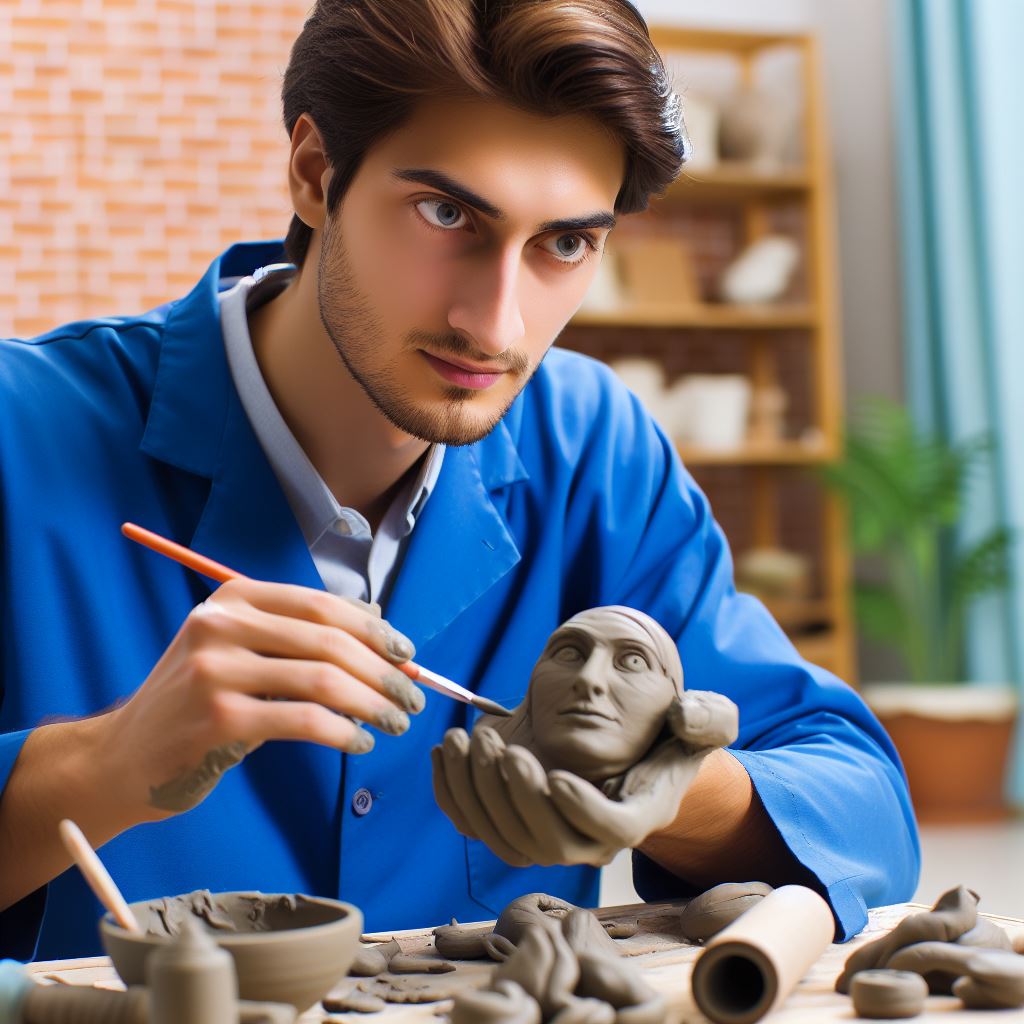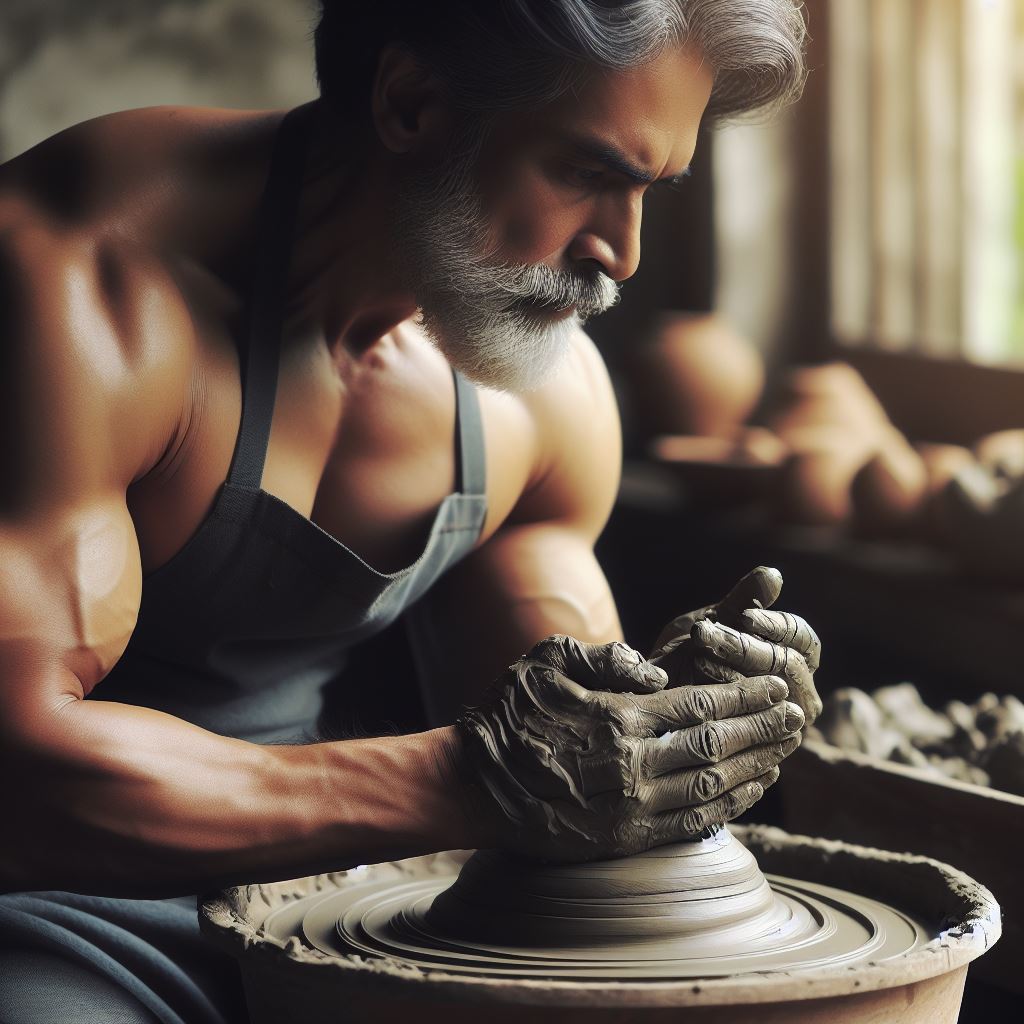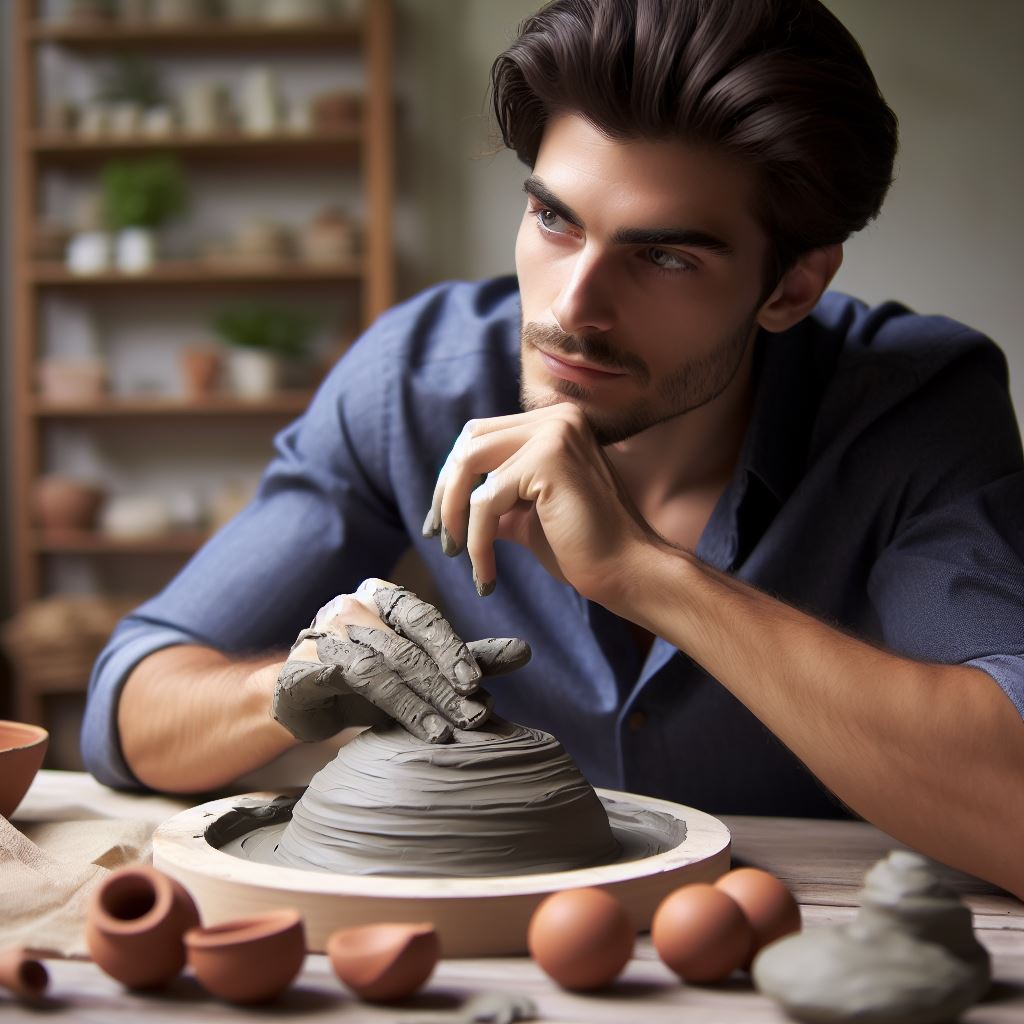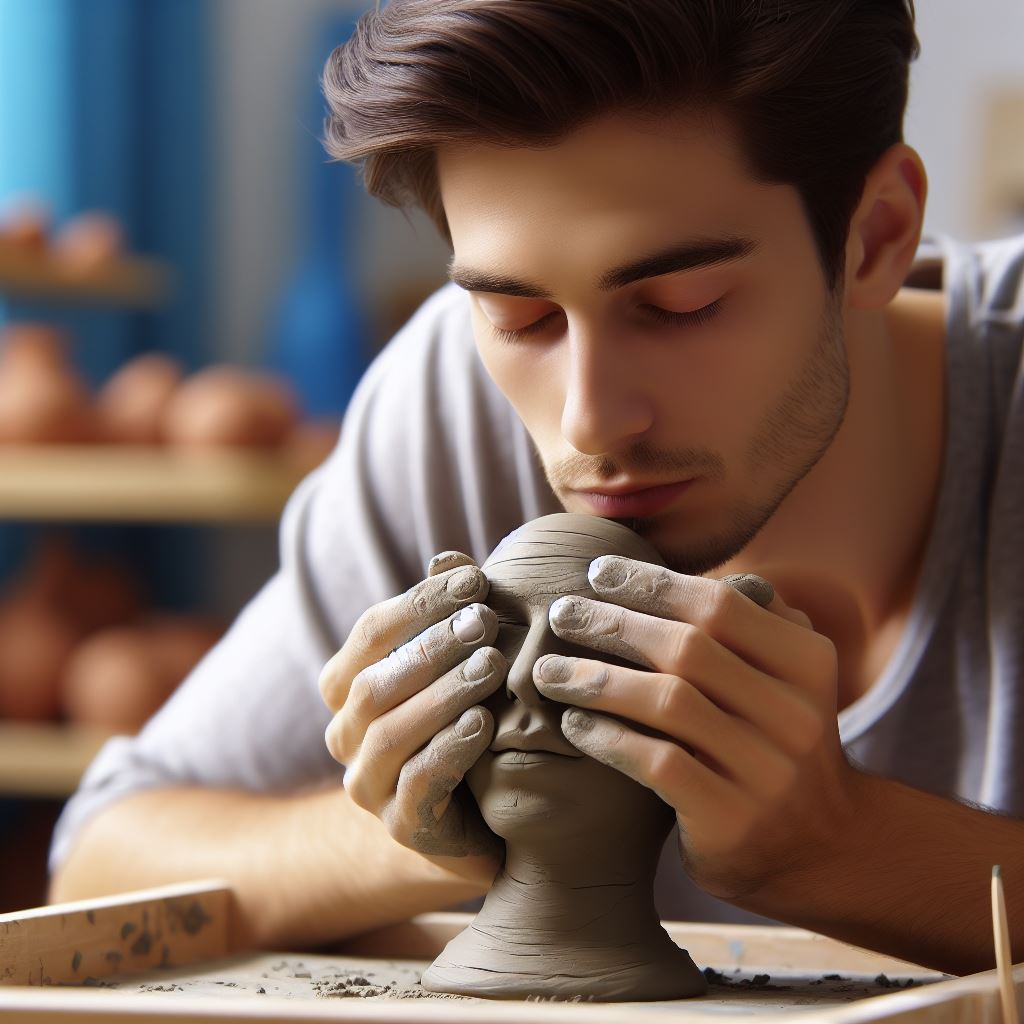Table Of Contents
- 1 Molding Minds and Muscles: Sculpting with Clay for Enhanced Hand-Eye Coordination and Fine Motor Skills
- 1.1 Here’s a glimpse of what we’ll discover:
- 1.2 Unmasking the Science: Sculpting with Clay and the Brain
- 1.3 Hand-eye coordination:
- 1.4 Fine motor skills:
- 1.5 Neuroplasticity:
- 1.6 Shaping Skills: Techniques and Exercises for Hand-Eye Coordination and Fine Motor Development
- 1.7 1. Pinch and Coil:
- 1.8 2. Textured Rolling:
- 1.9 3. Bead/Object Imprinting:
- 1.10 4. Blind Sculpting:
- 1.11 5. Mirrored Sculpting:
- 1.12 Conclusion
- 1.13 Key Takeaways:
- 1.14 FAQs:
- 1.14.1 1. Is sculpting with clay suitable for all ages and abilities?
- 1.14.2 2. What type of clay should I use for motor skill development?
- 1.14.3 3. How often should I sculpt with clay to see improvement in my hand-eye coordination and fine motor skills?
- 1.14.4 4. Are there any online resources or tutorials for learning clay sculpting techniques?
- 1.14.5 5. How can I overcome challenges and frustrations when sculpting with clay?
Molding Minds and Muscles: Sculpting with Clay for Enhanced Hand-Eye Coordination and Fine Motor Skills

From the moment we first grasp a crayon to the intricate movements involved in writing, playing sports, or crafting, hand-eye coordination and fine motor skills play a crucial role in our daily lives. These skills allow us to perform countless actions with precision and control, shaping our interactions with the world around us.
While many activities can stimulate hand-eye coordination and fine motor skills, sculpting with clay stands out as a particularly engaging and multifaceted option. This ancient art form offers a unique blend of sensory stimulation, creative expression, and physical manipulation, making it an ideal tool for individuals of all ages and abilities to enhance these essential skills.
In this four-part exploration, we will delve into the world of sculpting with clay, uncovering its fascinating benefits for hand-eye coordination and fine motor skills.
Here’s a glimpse of what we’ll discover:
- The intricate link between sculpting and motor skills.
- How clay provides a dynamic platform for skill development.
- Specific techniques that target hand-eye coordination and fine motor precision.
- The benefits of sculpting for individuals of all ages and abilities.
- Practical tips for incorporating sculpting into your daily routine.
By the end of this journey, you’ll be equipped with a deeper understanding of how sculpting with clay can empower you to build stronger, more coordinated hands, refine your fine motor skills, and unlock a world of creative possibilities.
Unmasking the Science: Sculpting with Clay and the Brain

Hand-eye coordination:
This complex skill relies on a intricate interplay between the visual system, sensory nerves, and motor pathways in the brain. When sculpting with clay, the eyes continuously scan the work in progress, sending signals to the brain. The brain then interprets these signals and instructs the muscles in the hands and fingers to manipulate the clay accordingly. This constant feedback loop between the brain, eyes, and muscles strengthens the neural connections involved in hand-eye coordination, leading to improved accuracy, precision, and dexterity.
Fine motor skills:
These delicate movements are crucial for activities like writing, drawing, using tools, and manipulating small objects. Sculpting with clay engages a variety of fine motor muscles in the fingers, hands, and wrists. The intricate movements involved in shaping, molding, and pinching the clay strengthen these muscles, enhance finger dexterity, and improve control over fine movements.
Neuroplasticity:
This remarkable ability of the brain to reorganize and adapt throughout life plays a crucial role in skill development. When sculpting with clay, the brain is constantly challenged to learn new techniques, adapt to different forms and textures, and refine its motor control. This continuous stimulation promotes neuroplasticity, leading to the formation of new neural connections and the strengthening of existing ones. This enhanced neural network translates into improved hand-eye coordination and fine motor skills over time.
Research supports the positive impact of sculpting with clay on motor skills. Studies have shown that engaging in clay sculpting activities can:
- Enhance hand-eye coordination in children and adults.
- Improve fine motor skills in individuals with developmental delays or neurological conditions.
- Reduce tremors and improve hand function in patients with Parkinson’s disease.
- Promote cognitive development and motor skills in young children.
Beyond the scientific evidence, the benefits of sculpting with clay extend to emotional and mental well-being. The tactile and creative nature of this activity can provide a sense of calm and focus, reduce stress and anxiety, and promote cognitive flexibility and problem-solving skills.
Shaping Skills: Techniques and Exercises for Hand-Eye Coordination and Fine Motor Development

Now, let’s transition from theory to practice, exploring some specific techniques and exercises that you can incorporate into your clay sculpting routine.
These techniques and exercises are designed to target different aspects of hand-eye coordination and fine motor skills, providing a progressive path for skill development.
1. Pinch and Coil:
- This foundational technique involves pinching small pieces of clay and rolling them into coils. Joining these coils together allows you to create a variety of simple shapes and forms.
- This technique strengthens fine motor muscles in the fingers and hands, promotes finger dexterity, and enhances hand-eye coordination as you manipulate the clay into desired shapes.
2. Textured Rolling:
- Use textured rollers or stamps to create various textures on the surface of your clay. This can involve simple patterns or intricate designs.
- This activity refines fingertip control and dexterity, enhances hand-eye coordination as you manipulate the roller or stamp with precision, and stimulates sensory perception through the tactile experience.
3. Bead/Object Imprinting:
- Press small beads, buttons, or other objects into the clay to create unique patterns and textures.
- This technique requires precise hand-eye coordination to position the object and apply the right amount of pressure for a clear imprint. It also strengthens finger muscles and enhances fingertip control.
4. Blind Sculpting:
- Challenge yourself by sculpting with your eyes closed. This forces you to rely solely on tactile feedback and hand-eye coordination to create a desired shape.
- This activity significantly enhances your touch sensitivity, strengthens the neural connections between your hands and brain, and promotes a deeper understanding of form and texture through tactile exploration.
5. Mirrored Sculpting:
- Work with a partner to sculpt the same object, mirroring each other’s movements. This requires close collaboration, communication, and precise hand-eye coordination to achieve the same outcome.
- This activity boosts communication skills, teamwork, and hand-eye coordination as you strive to match your partner’s movements and create identical sculptures.
Remember to start with simple techniques and gradually progress to more complex ones as your skills develop. Consistency is key to reaping the full benefits of these exercises. Aim to incorporate clay sculpting into your routine regularly, even if it’s just for short periods each day.
In addition to these specific exercises, here are some general tips for maximizing the benefits of sculpting with clay for hand-eye coordination and fine motor skills:

- Focus on precision: Pay close attention to the details of your sculpting and strive for accuracy and control in your movements.
- Use different tools: Experiment with various sculpting tools like knives, rollers, and stamps to engage different muscle groups and enhance overall skill development.
- Change your perspective: Try sculpting from different angles and positions to challenge your hand-eye coordination and refine your spatial awareness.
- Make it fun: Choose projects that you find enjoyable and engaging to maintain motivation and make the process more rewarding.
By incorporating these techniques and tips into your clay sculpting practice, you can unlock a powerful tool for enhancing your hand-eye coordination, refining your fine motor skills, and experiencing the joy of creative expression.
Conclusion
As we conclude our journey through the transformative world of sculpting with clay, let’s recap the key points and address any lingering questions you may have.
Key Takeaways:
- Sculpting with clay provides a unique and engaging platform for enhancing hand-eye coordination and fine motor skills.
- The tactile nature of clay stimulates various sensory pathways, leading to improved finger dexterity, hand control, and precision.
- Specific sculpting techniques like pinch and coil, textured rolling, and bead imprinting target different aspects of motor skills and offer progressive skill development.
- The act of sculpting engages the brain in complex neural processes, promoting neuroplasticity and strengthening the neural connections involved in motor control.
- Sculpting with clay offers benefits beyond motor skill development, including stress reduction, improved cognitive flexibility, and enhanced creativity.
FAQs:
1. Is sculpting with clay suitable for all ages and abilities?
Yes, sculpting with clay is a versatile activity that can be enjoyed by individuals of all ages and abilities. The level of complexity and difficulty can be easily adapted to suit individual needs and skill levels.
2. What type of clay should I use for motor skill development?
Polymer clay is a popular choice for beginners due to its air-drying properties and ease of use. Other options include stoneware, earthenware, or self-hardening clay.
3. How often should I sculpt with clay to see improvement in my hand-eye coordination and fine motor skills?
Regular practice is key to seeing significant improvement. Aim to incorporate clay sculpting into your routine at least a few times a week, even if it’s just for short periods.
4. Are there any online resources or tutorials for learning clay sculpting techniques?
Numerous online resources offer tutorials, workshops, and courses for all levels of experience. Explore websites like YouTube, Skillshare, and Creativebug for a diverse range of learning materials.
5. How can I overcome challenges and frustrations when sculpting with clay?
Embrace mistakes as learning opportunities and remember that skill development takes time and patience. Start with simple projects, gradually progress to more complex ones, and don’t hesitate to seek help from experienced sculptors or online communities.
Sculpting with clay is not just about shaping material; it’s about shaping your mind and skills. By incorporating this ancient art form into your life, you can unlock the potential for enhanced hand-eye coordination, refined fine motor skills, and a world of creative possibilities. So grab some clay, explore your creativity, and embark on your own transformative journey!
1 thought on “Sculpting With Clay For Improving Hand-Eye Coordination And Fine Motor Skills”